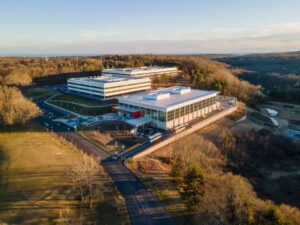
Online education is higher education’s new muse for improving the student experience, but some things may never change. Institutions prioritizing expanding their physical presence with masterclass facilities are increasing their academic offerings, student perks and enrollment prospects.
Better yet, they’re doing so sustainably and cost-effectively. Institutions such as the University of California, Los Angeles; Brown University; and George Washington University; and more are purchasing defunct buildings and renovating them to beef up their value.
After doubling its campus size in 2016 by purchasing a 500,000-square-foot complex from General Electric, Sacred Heart University (Conn.) has doubled its offerings—a few times over. On the academic side, the expanded campus hosts its college of business, college of education and school of social work. It also recently constructed a hockey stadium, administrative offices, workspaces, an auditorium and a reception area.
For President John Petillo, the physical space helped his administration expand its horizons on what a SHU education means.
“Your vision could be unlimited in providing new living environments,” he said. “Ninety-five percent was conceived after we bought it because we figured we’d only use one or two floors in the next five years. And here we are.”
Iona College, located in New Rochelle, N.Y., crystallized into Iona University after expanding into Bronxville, opening a new school of health sciences in facilities once owned by Concordia College, which closed in 2021.
Thanks partly to the expansion, Iona has upped its enrollment by nearly 30% since 2019 and was ranked 66th in The Wall Street Journal’s latest college ranking. The ranking remarked on its expanded academic programs and student experience for the nod, Cision reports.
One person’s trash is another’s treasure.
What to consider when remodeling
SHU collaborated with The S/L/A/M Collaborative, an architecture firm, to gut the inside of old office buildings and reimagine them into something more significant. SLAM has worked with universities nationwide, including Notre Dame, Emory University, MIT and the University of California, Irvine. According to Kevin Herrick, principal at SLAM, three-quarters of his work now is in renovation.
Herrick’s primary concern when remodeling old buildings is ensuring they help deeply cultivate the student experience. He completes this in two ways: providing the physical space fosters human connection and program collaboration.
“It was all about the relationships,” he said. “We had to change students who came to this building and give them places where they could bump into one another, sort of this mixing pod of students.”
He remarked on the importance of redesigning GE’s parking lot below an office building, a critical difference between the employer and student experience.
“If we were working there, we would drive our car in the comfort of an indoor parking lot. We’d park our car, walk right to an elevator, and go right to our desk,” he said. “If you were to do that on a college campus, the students would never be bumping into one another and never creating those sorts of social connections.”
Additionally, colleges are increasingly designing buildings that cultivate cross-industry collaboration that reflects a changing marketplace. For example, SHU’s IDEA Lab contains a wet lab, a design studio, and a lab focusing on AI. As a result, SLAM had to conform to a dynamic space that could comfortably house these different apparatuses while inspiring students to check in on their neighbors.
“This space enabled us to grow and to provide contemporary learning,” said President Petillo. “This is really all on-ground learning there. It provided us the opportunity to give not just classrooms but socially engaging spaces.”







